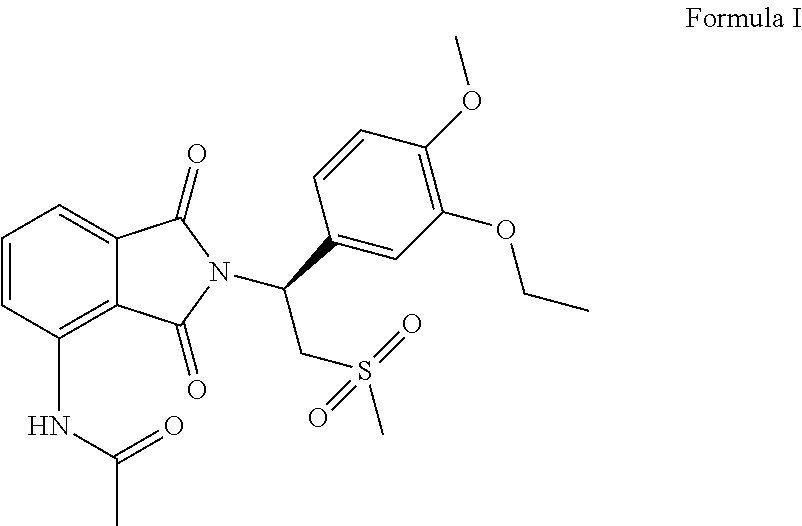Process for the preparation of apremilast
a technology of apremilast and apremilast, which is applied in the field of process for the preparation of apremilast, can solve the problems of complex process, difficult to carry out, and high cost of process, and achieve the effects of reducing reaction volume, reducing overall cost of production, and reducing reaction tim
- Summary
- Abstract
- Description
- Claims
- Application Information
AI Technical Summary
Benefits of technology
Problems solved by technology
Method used
Image
Examples
example 1
Ethoxy-4-methoxyphenyl)-2-(methylsulfonyl)ethanamine N-acetyl-L-leucine salt (N-acetyl-L-leucine salt of Formula III) Step (I)
[0097]To a reaction mixture of 700 ml methanol and 100 grams (gm) (0.366 moles) of 1-(3-ethoxy-4-methoxy phenyl)-2-(methylsulfonyl) ethanamine, 38 gm (0.2196 moles) of N-acetyl-L-leucine was charged. The reaction mixture was heated to reflux for 1 hour. The reaction mixture was cooled to 25° C. to 30° C. and stirred for 1 hour. The product was filtered and washed with 100 ml methanol. The obtained solid material was dried under vacuum at 30° C. to obtain (S)-1-(3-ethoxy-4-methoxyphenyl)-2-(methylsulfonyl) ethanamine N-acetyl-L-leucine salt.
[0098](Yield=68.0 gms)
[0099]R-isomer: 0.5%
example 2
no-2-(1-(3-ethoxy-4-methoxyphenyl)-2-(methylsulfonyl) ethyl) isoindoline-1,3-dione of Formula II (Step II)
[0100]Reaction mixture of 100 ml acetonitrile, 10 grams (gms) (0.0554 moles) of 3-amino phthalic acid, 15 gms (0.0336 moles) of (S)-1-(3-ethoxy-4-methoxyphenyl)-2-(methyl sulfonyl) ethanamine N-acetyl-L-leucine salt, 13.26 gms (0.221 moles) of acetic acid were stirred at 25° C. for 10 minutes. 11.16 gms (0.11 moles) of triethylamine was slowly added to the reaction mixture. The mixture was heated to reflux temperature (approximately 80° C.) and maintained for 3 hours. Solvent was completely distilled under vacuum at 45° C. Water (150 ml) was charged and stirred for 3 hour at 25° C. to 30° C. Solid was filtered and washed with water. The obtained solid material was dried under vacuum at 50° C. to obtain (S)-4-amino-2-(1-(3-ethoxy-4-methoxyphenyl)-2-(methyl sulfonyl) ethyl) isoindoline-1, 3-dione.
[0101]Yield=13.0 grams
example 3
on of Apremilast of Formula I (Step III)
[0102]To a reaction mixture of 100 ml ethyl acetate, 10 grams (gms) (0.0239 moles) (S)-4-amino-2-(1-(3-ethoxy-4-methoxyphenyl)-2-(methylsulfonyl) ethyl) isoindoline-1, 3-dione, 8.25 gms (0.0598 moles) potassium carbonate, was charged 5.6 gms (0.0717 moles) of acetyl chloride at 25° C. to 30° C. The reaction mixture was refluxed for 3 hours and monitored by thin layer chromatography (TLC). After completion of reaction, the reaction mixture was cooled to 25° C. to 30° C. The reaction mixture was extracted with water. The obtained organic layer was washed with 5% sodium chloride solution. Solvent was completely distilled under vacuum. 30 ml acetone and 60 ml ethanol was charged and stirred for 3 hours at 25° C. to 30° C. The solid was filtered and dried under vacuum to obtain apremilast.
[0103](Yield=9.0 grams)
[0104]HPLC purity 99.3% and R-isomer 0.82%.
PUM
| Property | Measurement | Unit |
|---|---|---|
| temperature | aaaaa | aaaaa |
| temperature | aaaaa | aaaaa |
| reaction time | aaaaa | aaaaa |
Abstract
Description
Claims
Application Information
 Login to View More
Login to View More - R&D
- Intellectual Property
- Life Sciences
- Materials
- Tech Scout
- Unparalleled Data Quality
- Higher Quality Content
- 60% Fewer Hallucinations
Browse by: Latest US Patents, China's latest patents, Technical Efficacy Thesaurus, Application Domain, Technology Topic, Popular Technical Reports.
© 2025 PatSnap. All rights reserved.Legal|Privacy policy|Modern Slavery Act Transparency Statement|Sitemap|About US| Contact US: help@patsnap.com



